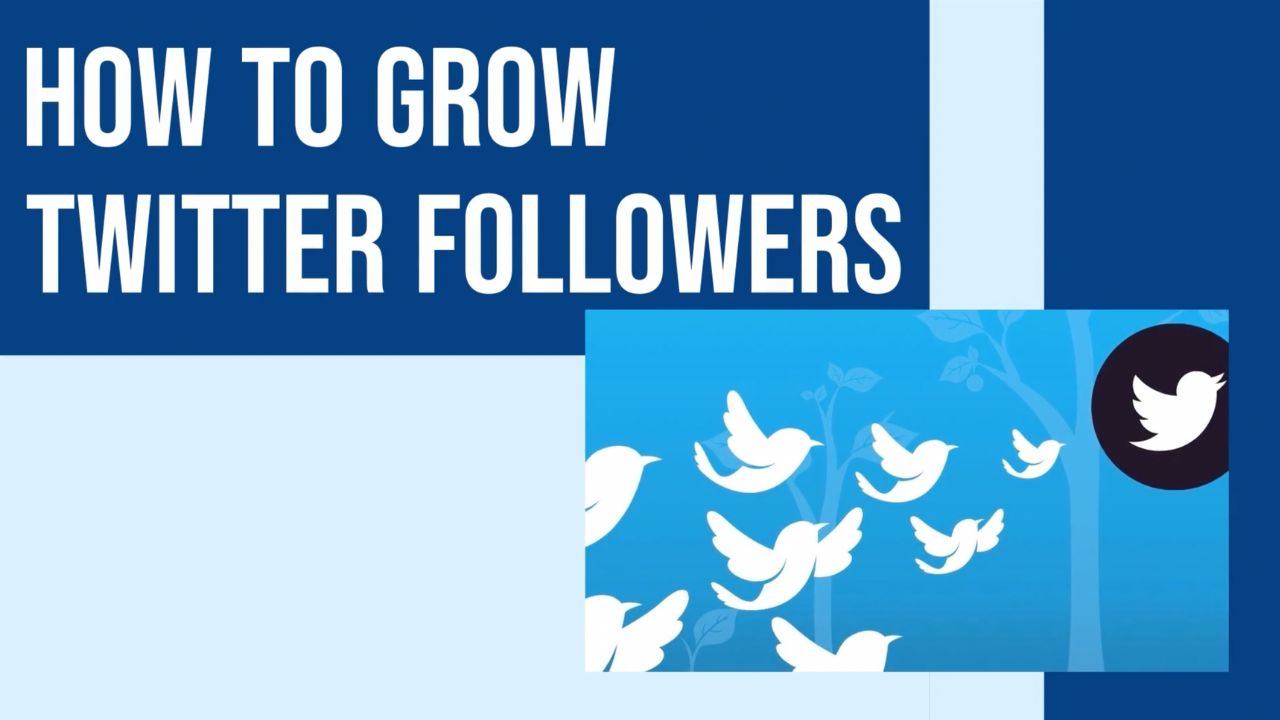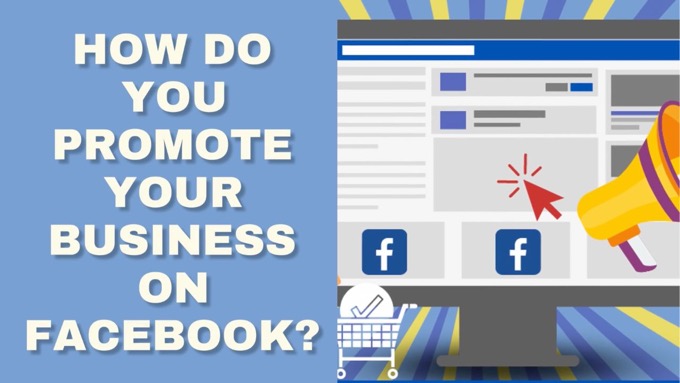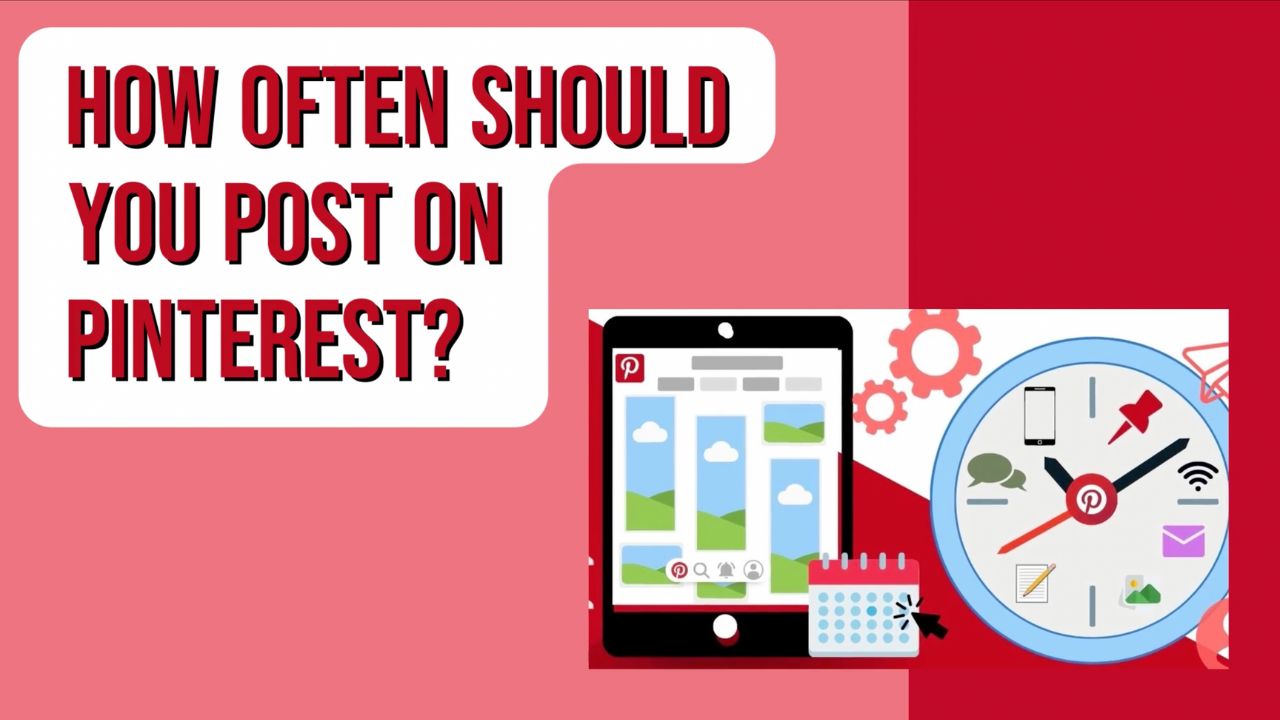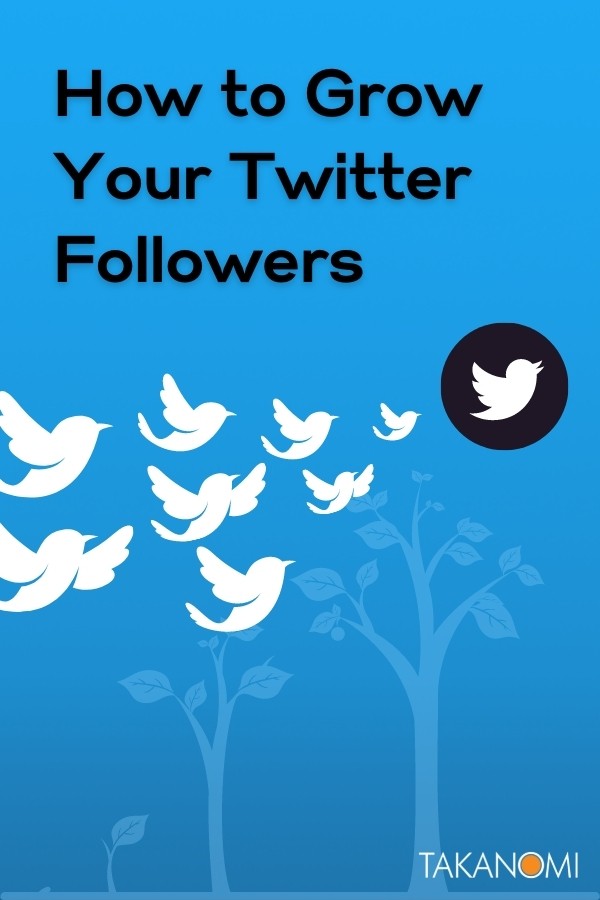We tend to follow people on Twitter because we find them interesting and the content they share relevant and helpful.
That's different to other networks, where followers may accrue because of some social obligation, such as a familial or work-based association, but where the commercial value of that follow is somewhat less.
In other words, your Twitter followers are inherently more valuable than many other social networks. For business purposes, that makes it a very powerful platform—and the pursuit of followers a worthy endeavour.
For example, Twitter users are 15% more likely to inform friends and family about new products and services that they hear about.
In addition:
- 74% of people following small and medium-sized businesses are following to get updates on future products.
- 72% of followers are more likely to make a future purchase.
- 47% of people following a business on Twitter are more likely to visit their website.
- Businesses attract a 30% increase in recommendations from those who follow (or interact with) them on Twitter.
More followers means easier content amplification. They give you increased levels of credibility, authority, influence, engagement with your content, traffic to your website, opportunities for expansion and growth, online visibility and a whole lot more.
In brief, by focusing on growing your Twitter followers, you're investing in the growth of your business.
With that in mind, this post gives you everything you need to know on how to grow your followers on Twitter, with ten top strategies you can start putting into action immediately.
Download this list of 10 top ways to grow Twitter followers so you have it to refer back to:
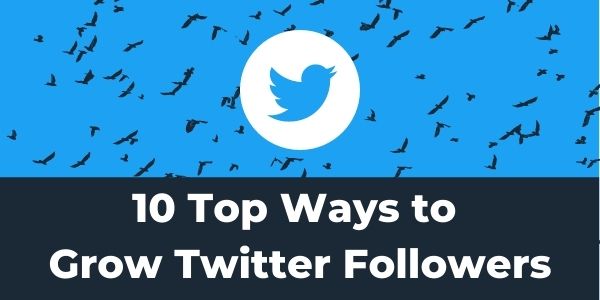
1. Tweet Regularly and Consistently
This is likely the most important and effective tip of all.
Unless you’re tweeting regularly and consistently, you’re mostly invisible to Twitter users who may otherwise follow you—and they’re unlikely to follow an account that looks inactive.
In contrast, when you’re showing up regularly, attracting retweets and your profile looks active, you’re providing a multitude of opportunities for people to follow you.
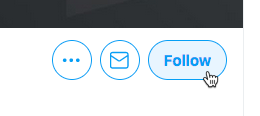
Twitter’s own advice on increasing followers reinforces this point:
“On Twitter, any given timeline is constantly changing. Make sure to post often to keep your Tweets at the top of the list… plan ahead of time and keep a consistent cadence.”
In other words, regularly and consistently.
(See this post for more info on how often you should be posting on Twitter).
Of course, you also need to make sure that the content you are sharing is going to be of interest to the type of person you want to attract.
This is mainly going to be people in your target market—who do you want to attract back to your website and onto your email list?
There’s little point in creating an audience on Twitter of people who will never become customers or otherwise add value to your business.
What type of content can you share?
For many businesses, it can be daunting knowing what to post on a regular basis.
But with a little planning, it’s easily achievable.
Here are some ideas:
- Tweets that share a link to new content you’ve published, either on your blog or other platforms. Use Twitter cards to make your Tweets visually engaging.
- Tweets that share an engaging image—this might be a relevant, inspiring quote for your niche overlaid on an image.
- Engage in public conversations.
- A purely text-based Tweet, perhaps sharing a thought or joining a conversation.
- A Tweet linked to content found elsewhere that your audience would find of interest—this could be a relevant article, a news item or a useful video.
- Ask questions.
- Run Twitter polls.

Avoid tweeting with the idea that every Tweet has to drive traffic back to your website or to content you've published elsewhere.
A mix of different types of Tweet works best. Aim to simply join the conversation in relation to your niche, sharing a mix of content likely to be of interest to the type of audience you want to attract.
Avoid trying to sell
For the most part, avoid sending Tweets where you’re trying to sell directly. After all, Twitter is a social platform, not a marketplace.
Some businesses, particularly newcomers to Twitter, struggle with this idea.
However, the main purpose of your Twitter account is not to sell, but to start and then build a relationship.
Once someone begins to know, like and trust you, the next stage is for them to ‘raise their hand’, and agree for more direct contact.
“... once people know, like, and trust you, the path to conversion is wide open.”
—Rand Fishkin
Generally, that means someone joining your email list, whether from a Tweet with a direct opt-in offer or via some content with a suitable call to action.
This marks a transition from relative anonymity within an audience to which you can only communicate en masse, to direct one-to-one communication straight to their inbox.
That transition makes it much more likely they will buy from you at some point, thereby marking a further transition in their customer journey from prospect to customer.
Trying to jump someone into buying something before they really know anything about you is more likely to backfire—losing followers, damaging fledgling relationships, preventing future sales, and deterring others from following—than win any sales.
Focus on adding value for your audience, while providing opportunities for them to find out more and deepen that relationship when ready to do so.
Space out your Tweets
Avoid bombarding followers with a rapid succession of Tweets, or you can lose followers annoyed by the deluge on their timeline.
The only place you can legitimately send out multiple Tweets all at once is when they're all related and part of a tweetstorm or thread.
Twitter displays these in the timeline as a single Tweet, which users then have to click through on to view the full thread.
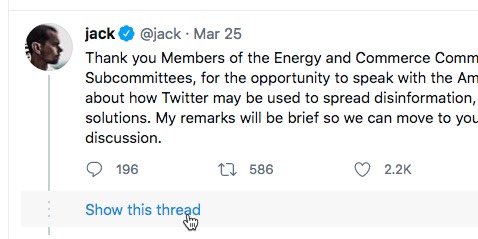
Focus on engaging rather than mindlessly broadcasting.
2. Use Hashtags
Twitter’s own research, after surveying 3.7 million accounts, found that Tweets with hashtags had double the engagement of those without.
To maximize followers, use hashtags every time. (See How Do Hashtags Work?)
I’ll let you know the optimal number to use shortly, but first…
How do hashtags work on Twitter?
People use hashtags on Twitter to find content they’re interested in.
They might search for relevant hashtags via Twitter’s search function.
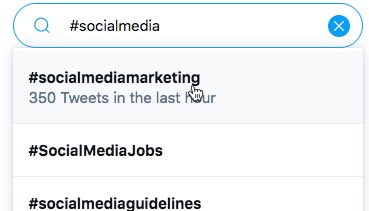
Or they may click or tap on the hashtag within a Tweet to find similar content—in other words, other Tweets that contain the same hashtag.
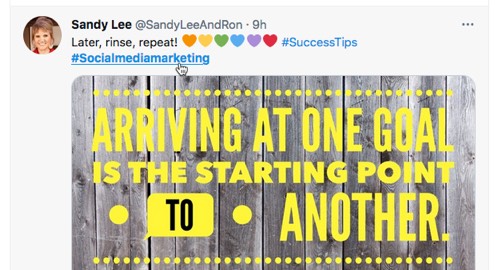
So when you include relevant hashtags within your own content, you’re helping potential followers to find you.
You’re aiding the discovery of your content.
Those who like your content and want to see more of it in future are likely to follow you.
Which hashtags should you use?
To add hashtags to your own Tweets, just use the hashtag symbol # before the relevant keyword or phrase.
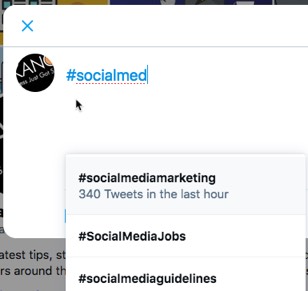
As you type, a list of the more popular hashtags appears that you can select from, or just continue typing to enter a new one.
For the most popular ones, Twitter shows the number of Tweets shared in the past hour.
However, note this only tells you the supply of content for that topic.
It doesn’t necessarily reflect the level of interest—the demand—for that content, although can:
- Reflect a popular or lively area of conversation.
- Indicate that others have found the hashtag to be effective.
But if some hashtags are oversaturated with content, you’ll be less likely to attract engagement—and followers—by using them.
Ultimately though, assessing interest level will require some further research, along with some experimentation.
Start by searching for some relevant hashtags for the type of content you share, and look at the type of engagement others are attracting with their Tweets.
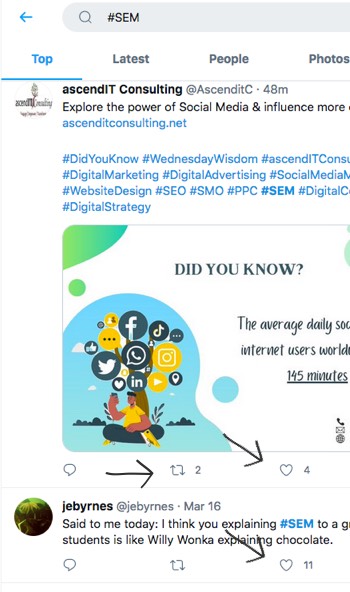
This isn’t an exact science, and the popularity of hashtags rise and fall over time, sometimes very rapidly, but it can give you a rough idea.
Then experiment over time to see which hashtags seem to generate the most interest and engagement for your market.
For some markets, you may also be able to take advantage of trending hashtags—to find them, click on Explore in Twitter, and then the Trending tab.
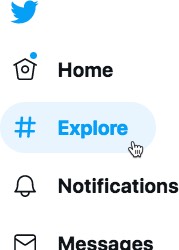
Trending hashtags indicate that there is a lot of conversation and activity happening in relation to that topic and can generate high engagement levels.
You can also plan ahead. Some popular ones appear:
- Weekly—here’s the list of main ones: #MondayMotivation (also #MotivationMonday), #TransformationTuesday, #WednesdayWisdom, #ThrowbackThursday (also #TBT), #FridayFeeling, #Caturday, #SundayFunday
- Yearly, such as #Thanksgiving, #Valentines, or #Christmas
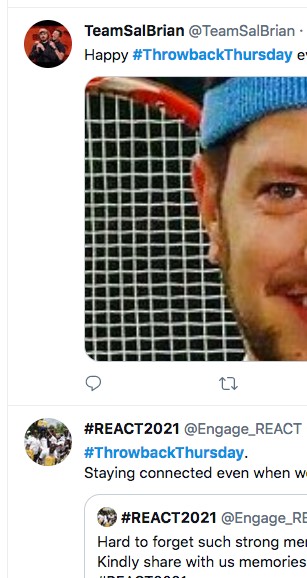
But before you jump in with trending or popular hashtags:
- Make sure you’re familiar with the type of content shared under that hashtag.
- Only use them if they’re relevant to the content you’re actually sharing.
- Be aware of Twitter’s policy on such hashtags, which refers to the following as ‘misuse’ of its platform:

Final hashtag tips
Here are a few final tips for using hashtags on Twitter:
- Include hashtags anywhere in your Tweet—for example, put them separately at the end; right at the beginning; or turn a keyword or phrase in the body of the Tweet itself into a hashtag, like this:

- Don’t overdo the use of hashtags in your Tweets, or it can look spammy and reduce engagement. Research has found that engagement drops by 17% if you use more than two. So as a general rule of thumb, include one or two hashtags, rather than every relevant hashtag you can think of.
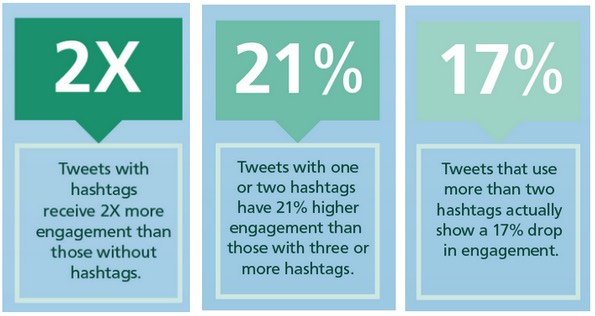
- Don’t use all capitals (unless it reflects an acronym) or it can feel like shouting and will look amateurish.
See this post for more info on how hashtags work on Twitter.
Download this list of 10 top ways to grow Twitter followers so you have it to refer back to:
3. Use Visuals
It’s obvious to most that more visual Tweets attract more attention and engagement than those without. It’s similar across other social media platforms.
In terms of actual stats for Twitter:
- Tweets with images attract 150% more retweets than those without.
- Tweets with video attract 10x more engagement than those without.
If you’re sharing links to content on your blog, make sure you’re using social meta tags.
They mean the difference between a Tweet that looks like this (no social meta tags):

And a Tweet that looks like this (social meta tags included):

Which one would you be more likely to engage with?
For info on how to start using social meta tags, click here.
They’re not just restricted to images, you can use social meta tags for videos too.
This is what makes a video show up in a Tweet when sharing a YouTube link (even when it is yet-another-cat-video).
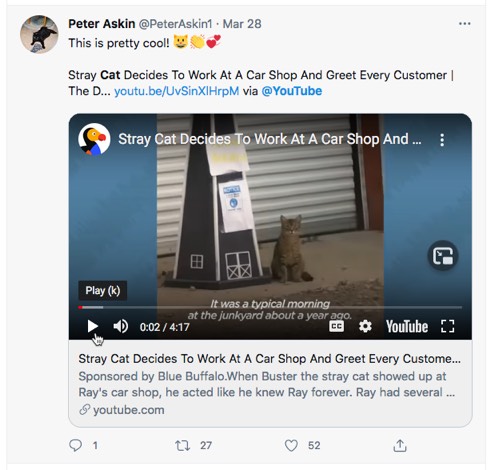
You can do the same thing if you have pages on your website you want to share that contain video.
But native videos on Twitter get even more engagement, resulting in:
- 2.8x more retweets
- 2.5x more replies
- 1.9x more favorites
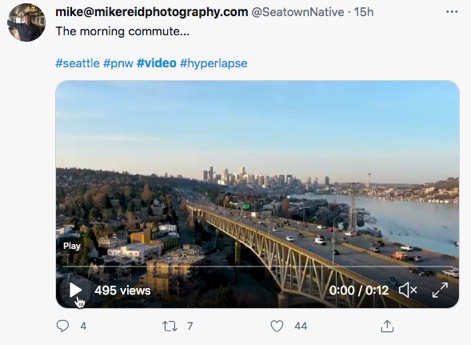
One way to take advantage is to upload a video directly to Twitter to add to a Tweet. Or you can record (and edit) a video to share via the Twitter app.
With either option, the maximum length is currently 2 minutes and 20 seconds.
Another alternative is to go live on Twitter, via the Twitter app.
4. Follow-Unfollow Others
This is a controversial tactic, involving following lots of Twitter users with the idea that a proportion will follow you back. You then unfollow them again a few days later.
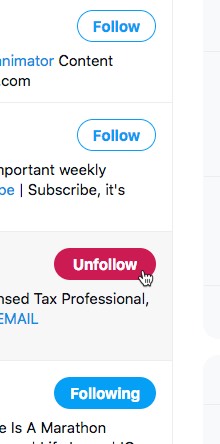
Some marketers are adamantly against it, others are for it.
Most use their own personal preferences—how they feel about it—to guide others.
One of the main arguments people use against it is to say that the additional followers you attract are largely a meaningless, vanity metric; that such followers don’t engage with your content.
But is that true?
Or just hearsay and opinion?
When you put follow-unfollow to the test...
Does it actually work?
While not particularly scientific, I’ve used this tactic previously, and found it effective.
I was wary of using automated software, figuring that was more likely to raise a red flag with Twitter and was aware of their policies on the issue.
So I took a manual approach, hiring someone to spend time doing it on a daily basis for me for a short while.
As a result, I found my followers definitely grew, as did engagement levels.
However, despite my supposedly-careful manual approach, my Twitter account was blocked for several weeks—I was probably in some way still overdoing it.
It can happen, and if you’re going to use this strategy, proceed with care.

With a more scientific approach, Agorapulse ran an experiment across three different Twitter accounts, following (and later, unfollowing) users who met one of the following criteria:
- Had tweeted relevant hashtags.
- Were followers of competitors.
Rather than doing it manually, they used some software to help (though they don’t name the programs), running the experiment over several months.
The result was a significant growth in followers.
Followers grew between 39% and 101%—over 14,000 new followers across the accounts—with the difference largely down to how long they ran the experiment on the different accounts.
But what about engagement levels?
They found that the engagement rate stayed at roughly the same level—0.8% before the experiment, 0.9% afterwards.
However, with the increase in followers, there were obviously more people engaging with their content—and therefore every other metric increased:
- Clicks on links rose from 587 to 846 (a 44% increase).
- Likes rose from 1,300 to 2,300 (a 77% increase).
- Retweets rose from 425 to 635 (a 49% increase).
- Replies rose from 345 to 655 (a 90% increase).
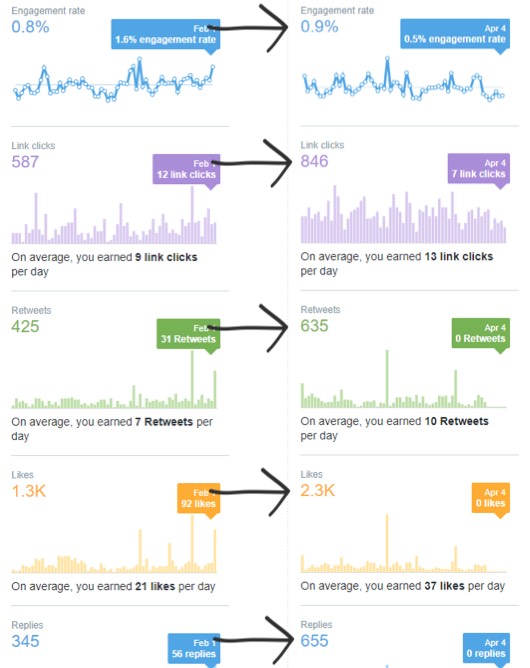
These numbers compared a two-month period prior to the test, with a two-month period afterwards.
While, as they readily admit, you can never fully correlate the increases to the new followers they attracted—there are always other factors involved—they felt it played a very significant role.
So they not only added over 14,000 new followers, but in terms of traffic, were now attracting over a hundred more visitors a month than previously, on an ongoing basis.
However, be aware of Twitter’s policies
Despite the positive-sounding experiment above, it should be noted that in early 2019, Twitter cut off certain apps that were using its API for just that activity—following and unfollowing users.
The experiment was run a few months beforehand (as was my own manual approach).
What do Twitter’s rules actually say about following-unfollowing accounts?
The following is from an older policy article on Twitter, originally available at the time of writing, but since taken offline:
“... we do monitor how aggressively accounts follow other accounts… We monitor all accounts for aggressive following and follow churn (repeatedly following and unfollowing large numbers of other accounts)... but if you don’t follow or unfollow hundreds of accounts in a single day, and you aren’t using automated methods of following accounts, you should be fine.”
Their updated policy is not quite as specific, but puts the following under a general heading of Misuse of Twitter product features (for which of course you can find your account suspended, temporarily or permanently):
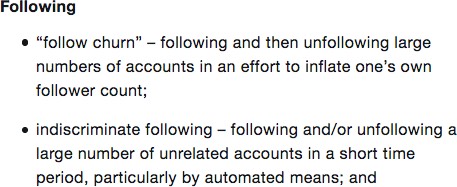
There are also limits in terms of the number of people you can follow. Once you’ve followed 5,000, additional limits apply depending on your followers-following ratio.
So what should your approach be?
If you find yourself with a suspended Twitter account, it obviously negates any benefit of trying to boost your followers in this way.
So, while following-unfollowing is proven to be effective in terms of increasing both followers and engagement, it should be approached:
- With a high level of caution.
- In a softly-softly manner.
- As part of the general mix alongside the other strategies in this post.
But never use software to help that accesses Twitter via their API.
Even Chrome plugins that purport to help can lead to account restrictions.
So if you use this strategy at all, proceed manually.
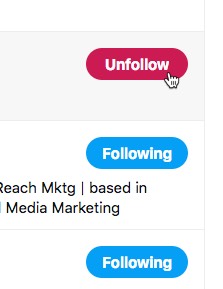
The wisest approach is probably to mainly either follow or unfollow accounts for say a month at a time, and then switch over.
If you’re in a period when you’re following people, just follow a few people a day likely to be interested in your content, such as:
- People following similar accounts.
- People tweeting with similar hashtags.
- People who engage with similar content to your own.
The latter I have found to be the most effective.
Then switch over to unfollowing, just unfollowing a few a day.
Whether following or unfollowing, don’t approach it too quickly or within a single time block.
A few here, a few there, a couple dozen or so a day in total, is probably fine. It could neither be called “aggressive” nor “a large number” and is unlikely to call your account into question.
5. Engage With Others
Using Twitter effectively isn’t solely about broadcasting, although many businesses approach it in that way.
It is of course a social platform, and many of Twitter’s distinct advantages come through using it more interactively.
A good way to drive up followers—and build relationships in general—is to engage with others rather than just wait for others to engage with your own content.
This includes doing the following on a regular basis:
- Replying
- Liking
- Retweeting
- Responding to Tweets that have tweeted or tagged you

In addition:
- Tag others in your own Tweets—such as people quoted in a post you’re sharing
- Engage in live Twitter chats
- Respond to (non-spam) DMs
Download this list of 10 top ways to grow Twitter followers so you have it to refer back to:
6. Grow Followers from Outside of Twitter
Outside of Twitter itself, there are of course ample opportunities to attract followers to you.
Here are just a few ideas, some of which you may already be using:
- Add your Twitter handle to your email signature—link it directly to your Twitter profile.
- Similarly, add to the email signatures used to respond to customer support requests, where different.
- Add a link to your website, such as in the footer of each page.
- Add to the author description shown at the bottom of posts.
- Embed Tweets sent via your profile in your blog posts.
- Add a link from your other social media profiles, such as LinkedIn and Facebook.
- Link to your Twitter account from your profile info on other content platforms such as Quora. Here’s how I do it:
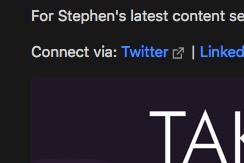
- Add to offline content such as business cards, marketing materials, books you’ve authored and so on.
- Suggest people follow you on Twitter when interviewed on podcasts and elsewhere.
- Add to SlideShare presentations and video content.
7. Create an Engaging Profile
To maximize the number of followers you attract, your profile should be as engaging as possible to both attract eyeballs and give potential followers an idea of the type of content they can expect.
To start with, make sure your profile is fully complete.
That starts with your profile image…
Profile Image
If you're tweeting as an individual, use a personal photograph of some kind.
People are far more likely to follow someone they can actually see, rather than someone who hides behind say an image of their pet cat (unless of course you’re actually tweeting on their behalf!).
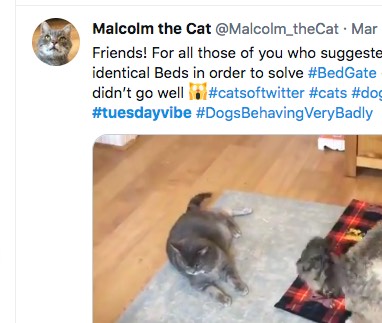
For business profiles, use something that reflects your brand.
The recommended dimensions for your profile image are 400x400 pixels.
For this and your header image, use consistent branding—whether for yourself or your business—across your social and content channels.
This helps and encourages those who follow you on one channel to recognize and follow you elsewhere as well.
Header Image
Not everyone who follows you will view your full profile and see it, but for those that do, you want it to reflect positively on you and what you do.
For inspiration, here’s what the header images from some well-known Twitter profiles look like.
First, a couple of individuals:

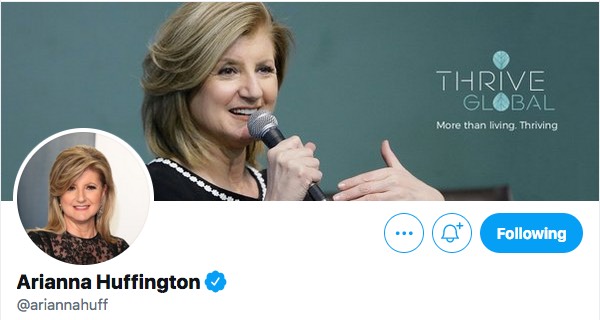
Second, from a couple brand accounts:

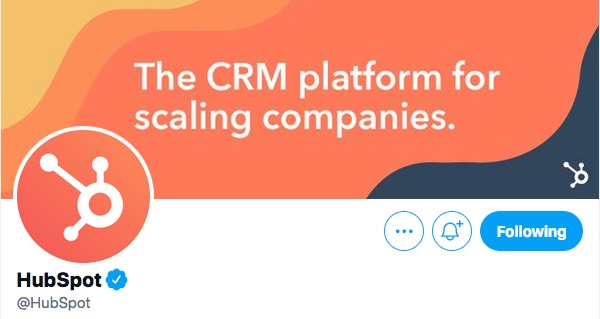
The maximum file size for your header image is 2MB, and the recommended dimensions 1500x500 pixels.
If you’re looking for a temporary option while you get yours designed, try one from Twitter’s gallery that they make available on Flickr.
Profile Name
The name of your Twitter profile is one of the first things people see, and therefore one of the most important aspects.
You actually have up to 50 characters available. For many users, the space is probably underutilized.
As an individual on Twitter, you’ll gain more trust from potential followers when you use your full name, rather than say just a first name, a single initial for first or last name, or even an invented word.
As a brand, you may want to include additional information to help attract followers interested in the type of content you share.
For example, I’ve just adjusted Takanomi’s Twitter profile for that reason, reflecting the business’s tagline.
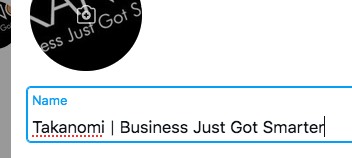
Profile Bio
Craft your bio so it describes what you do and the type of content likely to be shared.
The use of hashtags can help your profile stand out and appear more visually appealing.
Some people also use emojis for this reason (use them in your name too!)—use the emoji keyboard on your phone.
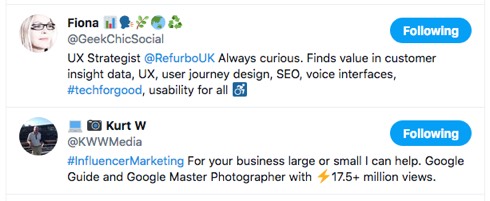
Or for desktop, here's a directory of emojis suitable for use on Twitter.
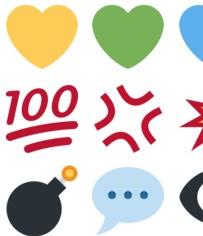
You can also add links to your bio, such as in Guy Kawasaki's profile shown here.
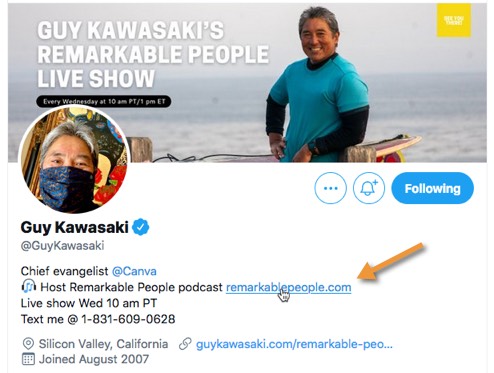
Also see how Chris Brogan approaches it in his profile shown below, where he links to a couple of his content hubs.
Profile Link
Where do you want to direct people to when they visit your Twitter profile?
Remember, your aim is to encourage people to know, like and trust you. Link to somewhere where people can find out more about you, which also grows your authority.
Here are some examples of how some influencers approach it.
Chris Brogan links to his About page (note his expanded use of the name field, and additional links in his bio):
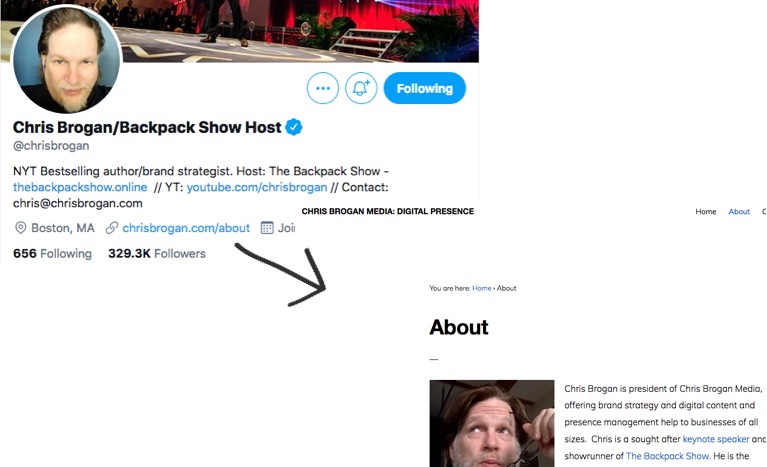
Mark Schaefer links to a page showcasing his public speaking skills:
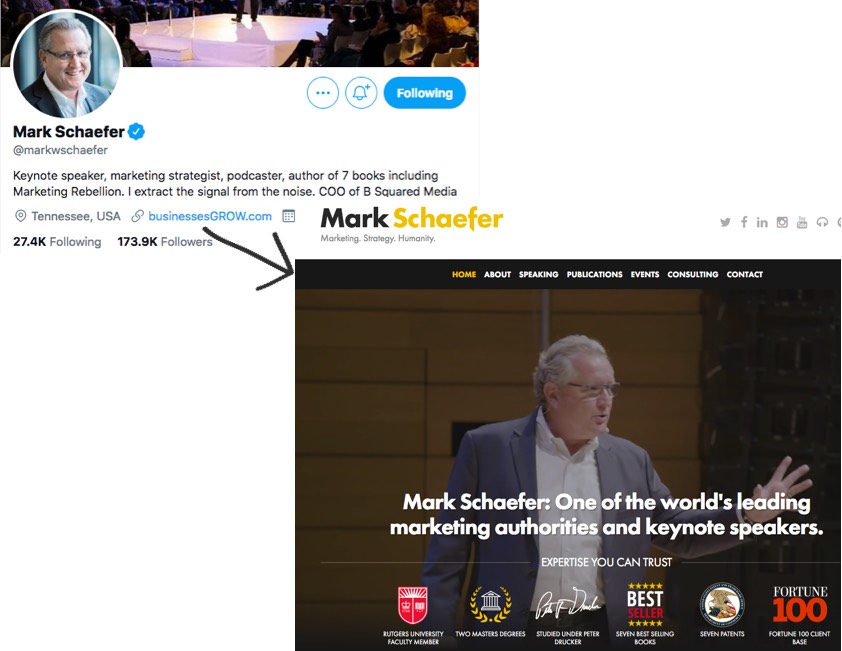
Mari Smith links to a page introducing herself to her audience:

Pin a Tweet
Finally, you have the option to pin a Tweet to the top of your profile.
According to Twitter, this should reflect “what you want your followers to focus on—your biggest, latest news”.
A pinned Tweet will stay at the top of your profile until you decide to change it. Some leave it there for months.
Some for years. Here’s an example from John Lee Dumas, pinning a Tweet from back in 2017:
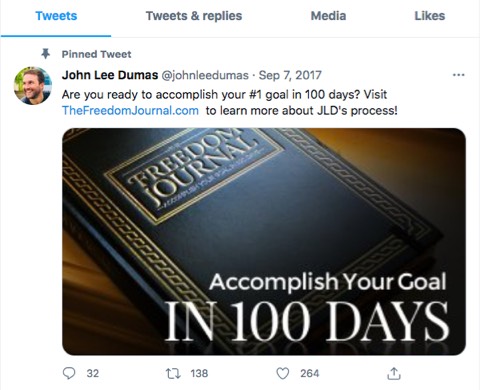
Your pinned Tweet could reflect:
- An offer of a free resource for lead generation.
- Content you have on another platform, helping you cross-pollinate audiences.
- A promotion of a related Twitter account.
- An ongoing sale or an upcoming product launch.
- A key message for followers, reflecting your philosophy or that of your brand.
Here are some more examples.
Jay Baer promotes his philosophy towards content marketing.

Neil Patel suggests a related Twitter account for users to follow:
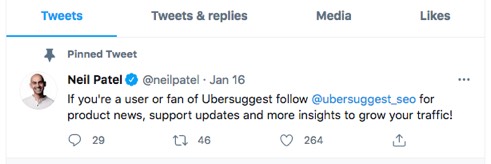
HubSpot uses the space to deflect support requests to the appropriate channels:

8. Use Twitter Ads
Organic methods will only get you so far.
Consider running an ongoing Twitter Ads campaign to attract followers as well.
Here are just some reasons why that can be worthwhile:
- It can greatly accelerate the pace at which your follower numbers grow, particularly useful if you’re just getting started on Twitter.
- As shared at the very beginning of this post, followers have real value—they are what increase your influence, your reach and the engagement levels you attract.
- The benefits are long-term, such as increased traffic back to your website, both from Twitter and, more indirectly, improved SEO.
Get started running a followers campaign via ads.twitter.com.

Click Campaigns > Create campaign from the menu, and select Followers as your objective.
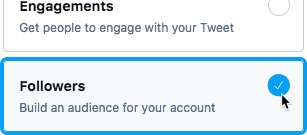
In the Campaign details:
- Give the campaign a name
- Set a daily budget—for an ongoing campaign, ignore the optional Total budget field
- The Start date and time is preset, but adjust if you need to—again, for an ongoing campaign, ignore the End setting
- Click Next
Then create an ad group—as a minimum:
- Set the Demographics to match your market profile—who are you looking to attract to your business?
- In Targeting features, again consider who you want to attract and what their characteristics are. One option is to consider other accounts whose followers are likely to also be interested in your content, and the type of products and services you provide.

Twitter recommends choosing text-only Tweets for followers campaigns, as they use a follower card that will replace any other media.
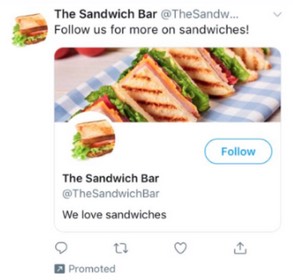
Have a few Tweets running within the campaign, so you can compare how your different messages are resonating with your intended audience, and adjust accordingly.
You can select some existing organic Tweets, but I prefer to create some Tweets just for the campaign (known as promoted-only Tweets).
To do so, click the Create Tweet button.

Once added, select the Promoted-only Tweets option from the dropdown, and select the Tweets you’ve just added.
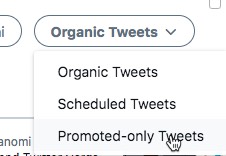
Click Next, launch your campaign and keep an eye on how it performs.
Download this list of 10 top ways to grow Twitter followers so you have it to refer back to:
9. Get Verified
When an account is verified, a blue verified badge is shown which, according to Twitter, “lets people know that an account of public interest is authentic”.
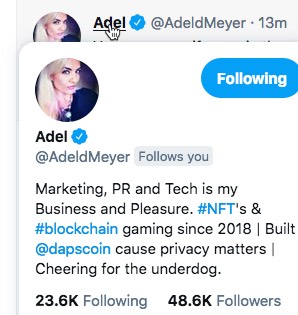
In other words, it gives an account an immediate status boost, affording it credibility, authority and trust.
It also helps your account to stand out visually, attracting more eyeballs.
The end result for verified accounts is an immediate lift in the number of followers they attract.
In other words, a verified account is well worth having.
Although Twitter withdrew the verification process back in 2017, it was relaunched in May 2021.

According to their guidelines, for an account to be verified, it must be “authentic, notable and active”, and fit into one of the following six account types:
- Government
- Companies, brands and non-profit organizations
- News organizations and journalists
- Entertainment
- Sports and gaming
- Activists, organizers and other influential individuals
If your account becomes inactive, a verified badge might then be removed.
10. Tweet at Optimal Times
Since early 2019, Twitter mobile users have been able to switch between seeing the latest Tweets, and those delivered by Twitter’s algorithm, with the latter set as the default option.
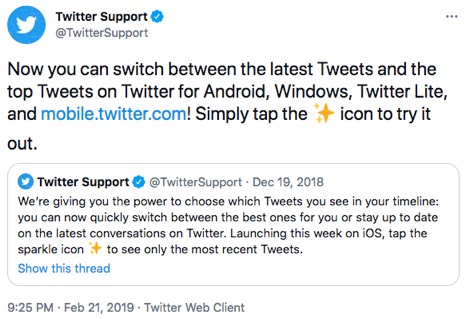
And on desktop, users can similarly switch between the latest or top Tweets via the two tabs.
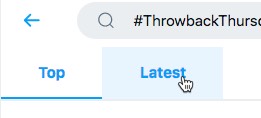
For many users, the whole point of Twitter is that they can discover things as they occur. While the algorithmically-delivered timeline is Twitter’s default option, the chronological feed remains a popular choice.
To maximize engagement, it’s therefore important to Tweet at optimal times.
By catching the attention of followers at the right time via the chronological feed, the increased engagement can then help your Tweets surface higher within Twitter’s top tweets, where engagement levels play a key part.
Having said that, there’s various advice available on when you should Tweet, including days of the week and times of day.
It’s particularly relevant if your followers—or people you want to follow you—are predominantly in the same time zone.
However, most accounts will attract global followers, in which case timings should reflect where your predominant market is based and who you want to attract.
Take my own business for example.
Although based in England, and with a global customer base, my predominant market is North America. Within that, there's a three hour time difference between the east and west coasts.
So I tend to focus timings predominantly around that, but also send Tweets outside optimal times for that market too as I’m more than happy to attract followers from other countries too.
Twitter’s own research suggests maximum engagement comes from Tweets sent between noon and 10pm local time.
Other research suggests the optimal time within that is between 9pm and 10pm, particularly if you’re predominantly US-focused. However, not everyone agrees, with CoSchedule reporting the times between 12pm and 7pm as optimal for retweets.
Others suggest different timings again.
Research from SproutSocial found that the best time for global engagement is on Wednesdays and Fridays at 9am CST (Central Time Zone), with Wednesdays and Fridays also being the best days generally, and the worst day Saturday.
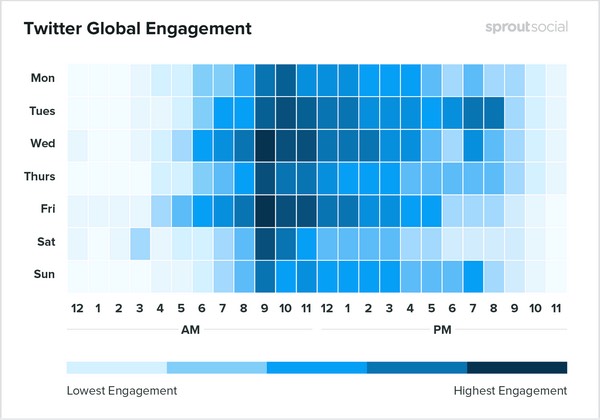
However, this also differed by industry, for example:
- For businesses offering consumer goods, best day is Sunday, optimal time 11am CST, and worst day Monday.
- For media industries, best times are Wednesdays 9am and Thursdays, both 9am and 8pm; best days are Thursdays and Fridays; worst day Saturday.
- For those in tech, best time is Tuesday 9am, best days Tuesdays and Wednesdays, and the worst day Sunday.
The research available tends to differ quite a lot, so ultimately you need to experiment, find out the timings that seem to attract the best results for you, and then formulate your strategy around that.
To Conclude
That’s everything you need to know on how to grow Twitter followers—ten top strategies you can start putting into action today.
Remember, time spent growing your Twitter followers is time well spent for the future success of your business, and a solid part of an effective organic content marketing strategy.
So set aside some time everyday to focus on growing your followers on Twitter using the strategies described here—you’ll see your followers start to grow in no time.
Finally, take two secs to grab your free copy of this list of 10 top ways to grow Twitter followers so you have it to refer back to:
Download this list of 10 top ways to grow Twitter followers so you have it to refer back to:
